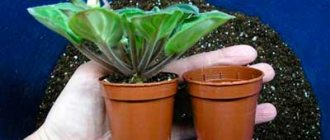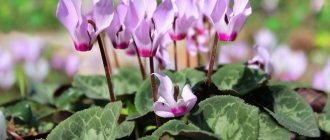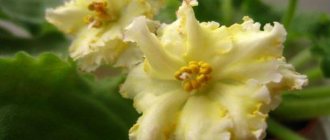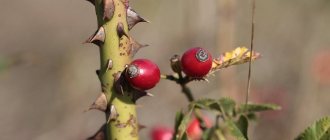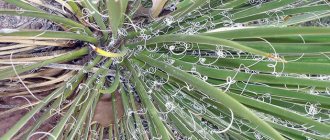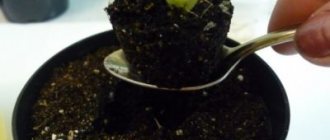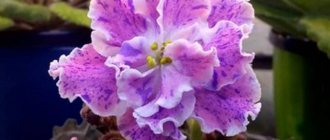The amazing violet variety “Goddess of Beauty” has earned the love of flower growers due to its rare beauty and unpretentiousness.
Dear readers!
For you, we have created communities on social networks in which useful articles and interesting ideas are published several times a day! Subscribe and receive useful content in a convenient format! One of the big advantages of this flower is its huge, approximately 7 centimeters, densely double inflorescences, pleasing the eye of even the most fastidious connoisseurs of beauty. Its flowers are double, and the edges of the petals are wavy - to obtain this result, the breeder had to put in a lot of effort, and it fully justified itself. Such a flower simply cannot fail to attract attention!
You can grow such a flower from just one leaf, but in order to get lush beautiful flowers, and not just leaves, you need to know how to care for it.
Description of the variety
The unusual and beautiful violet variety “Goddess of Beauty” really deserves the love and attention of flower growers.
In this article you will learn in detail how to grow it correctly and how to make it please its owners with lush, bright flowers for as long as possible, and how to treat it in case of illness
This indoor flower was bred in 2003 in Togliatti by Elena Vasilyevna Korshunova , who became famous thanks to her successful experiments in the field of selection. All varieties bred by her are affectionately called “kite kites” by breeders and flower growers. One of her best experiences was “Goddess of Beauty.”
Interesting! The varieties bred by Elena Korshunova have the prefix “EK-” in front of the name.
Leaves
Its leaves are plate-shaped, dark green, velvety.
They grow on long thin cuttings, spreading out in all directions. Some people recommend removing the lowest leaves for the sake of compactness, but this will not affect its health and flowering, so it remains a matter of taste and space options.
With age, the leaf rosette becomes smaller and loses its beauty, so it would not be superfluous to “rejuvenate” the flower every couple of years.
Flowers
It becomes especially beautiful, of course, during flowering.
Thanks to the efforts of breeders, its flowers reach amazing sizes - from seven to nine centimeters in diameter. There are a lot of color options: a variety of shades of pink with crimson, lilac, violet tints.
In some varieties, the ebbs cover the entire flower, in others they are located at the edge.
The only drawback of the flower is that the peduncles are too thin and long and cannot hold the heavy, beautiful inflorescences , which is why they gradually droop. But this drawback does not spoil the flower too much and even gives the “Goddess” tenderness and charm.
Important! This variety of violet cannot be planted in open ground even in the best climate: the delicate flower will not survive such changes.
Violet NK-House of the Sun (N. Kozak)
Delicate violet NK-House of the Sun.
Authorship of the variety
Flower growers first saw the wonderful violet with sunny flowers in the status of a seedling (in 2015), forced to fight for the high title of “variety”. The candidate was received by Odessa breeder Natalya Kozak, whose name is already quite authoritative in the violet growing community.
The master has been working enthusiastically on creating new varieties of Saintpaulia for six years and has an excellent line of varieties.
After some time, the seedling proved its viability and durability of decorative characteristics. In 2016 , it received the branded prefix “NK” and was registered as the official variety “NK-House of the Sun”.
The variety was created by Natalya Kozak.
Taxonomy
Guided by the taxonomic principles of the hierarchy, the violet “NK-House of the Sun” in botanical typology is assigned to the genus Saintpaulia (family Gesnerieceae), which is substantial in the number of included varieties and impressive in its decorative diversity:
- According to the diametric coefficients of dimensions, mature bushes represent standard subspecies;
- And in terms of filling the volume of the flower, they are a double variety.
The variety has double flowers.
Photo and description of the variety
A chic Saintpaulia with a neat configuration lays out its leaf plates in tiers in perfect order without the help of flower growers, independently creating its own decorative appearance. Violet bushes, according to the digital indicators of their dimensions in adulthood, fully fit the standard classification coefficients.
Leaves have :
- Average indicators for the entire Saintpaulia genus;
- Symmetrical, emphasized by slight lightening, but not a sharply prominent venation pattern;
- Smooth surface;
- And an oval shape with a small point at the end.
The lateral edges of the leaves differ :
- Slight waviness;
- And smoothly - with a rounded serration structure.
The variety has oval-shaped leaves.
NOTABLE! Occasionally, regular violet leaf blades may form the outline of small shuttles due to wavy uplifts of the edge, or appear completely smooth at the edge, folding their jagged edges down.
The leaves are painted in a rich tone of summer greenery.
Saintpaulia is distinguished by large, voluminous semi-double flowers, obtained due to the average filling of the corolla with petals and their wavy-frilled structure.
The flowers are white.
Through the veil of petals, the bright yellow core is clearly visible , casting yellowish reflections on the bases of the petals. The white flowers soaked in sunlight at the center explain the name given to the variety.
Sports
holds varietal characteristics quite , only sometimes forming sporty specimens with two to three petals, colored pinkish.
Occasionally, sports appear in the variety.
Photo of violet EC “Goddess of Beauty”
Features of care
Like any plant, this variety needs certain conditions; let’s look at them in more detail.
Priming
The goddess prefers soils with turf, pine needles, peat and humus, and requires annual replanting to avoid infection, disease and mold. In order to simplify the choice of soil, you can simply purchase specialized soil for violets - it will be quite suitable for the plant.
Pot
The “Goddess of Beauty” has no special preferences in terms of pots; pots traditional for violets with a diameter three times smaller than the rosette of the plant are suitable - this is traditional for all violets; in too wide ones they grow poorly and almost do not bloom.
Don’t forget to put a little expanded clay or special moss on the bottom for drainage ; all this can be purchased at any flower shop.
Lighting
This variety of violets loves bright light without directly directed rays of the sun, as they cause burns and spotting in the delicate “goddesses.” For better flowering, experienced gardeners install lamps directly above them (fluorescent ones are best suited). They need 12 hours of light per day.
Attention! In order to understand that the plant needs more light, pay attention to the leaves: when a violet pulls its leaves up, it means that it does not have enough light.
Temperature
Violet does not require special temperature conditions: 20-24 degrees Celsius - normal conditions in an apartment - the ideal regime for violets. Similarly with humidity: no unnecessary manipulations, the conditions in the apartment are quite sufficient for active flowering and flower health.
Reviews about violet
Varvara Ilyinichna: I want to share interesting observations. I am quite closely involved in growing violets from the NK variety line (Natalia Kozak), I have kept many varieties before and recently acquired several varieties. Among them is the magnificent violet “NK-House of the Sun” with corollas similar to magnolia flowers. Thanks to personal experience, I can say with confidence that almost all of this master’s Saintpaulias do not show their bright varietal characteristics in the first flowering; this appears only at the stage of the second formation of buds.
Advice to all flower growers - do not give up on these varieties immediately after the first flowers, give violets a chance and wait for the next flowering. Violets will surprise and delight you.
Saintpaulia inspires many gardeners.
Emmanuil Dmitrievich: The appearance of the violet “NK-House of the Sun” somewhat reminds me of a blooming southern magnolia: large white flowers with a yellowish light seeping from the middle, against the backdrop of lush, elastic foliage of a classically green hue. I received a leaf from a varietal plant at the first exhibition with the participation of the variety. The violet formed easily, the rosette is magnificent in its configuration, the flowers are of a respectable size. The plant blooms often and for a long time. I recommend this variety to all gardeners.
Flower propagation methods
The most popular and easiest way to propagate this variety is vegetative.
You just need to carefully cut off the leaf on the petiole with a disinfected blade. Afterwards, there are two options: in the first case, you just need to put it in water and wait until the roots appear.
When they appear, the plant can be planted in the ground.
To be more reliable, it is better to use ready-made soil, a peat tablet, a mixture of peat and vermiculite, or agroperlite. Then you can simply pour the prepared mixture into a small pot, up to 2.5 cm in radius, plant a leaf there, pour in clean, settled water and cover with cling film or a bag.
The mini-greenhouse needs to be ventilated every other day and watered if necessary, and when transplanting, open the greenhouse gradually.
Find out also about other varieties of violets on our website: “Southern Night”, “Sea Wolf”, “Chateau Brion”, “Dance of the Galaxies”, “Black Pearl”, “Angelica”, “LE Isadora”, “Duchess”, “ Winter smiles" and others.
Useful video
Find out in the video which fertilizers are suitable for violets: Interesting facts in the video about the temperature conditions for Saintpaulias: Video instructions for replanting violets after purchase: Watch the video all about the rack for Saintpaulias:
Caring for the “goddess”
Violets are unpretentious in care, and this variety is quite easy to care for.
How to water?
It should be watered at the root with settled water, not cold or hot; in terms of spraying, the opinions of gardeners are divided.
Some people believe that violets should never be watered, while others are sure that regular bathing in warm water is good for the flower. Mostly people adhere to the first opinion.
Transfer
It is advisable to carry out transplantation once a year systematically or if necessary.
Just carefully remove the plant from the pot, carefully free the roots from the soil, remove the rotting roots, and then plant the plant in fresh soil in another pot.
Don't forget to place drainage at the bottom!
Top dressing
Instead of fertilizing, you can simply regularly replant the “Goddess of Beauty” into a slightly larger pot with fresh soil - in this case, it will feel great and decorate the room without any extra fertilizing or labor.
Keeping at home
The violet is satisfied with the standard care for most varieties :
- Growth on western or eastern window sills;
- Dosed watering after a short drying;
- Rare feeding;
- Diffused spectrum of lighting;
- Maintain +20 + 24°C;
- Aerated, permeable soil with drainage;
- Transshipment preference.
Violets must be properly cared for.
With the exception of minor nuances, violet is characterized by a classic course of all life phases for the genus , which makes it easier to develop care regimens. This also gives beginning violet growers the opportunity to purchase the variety for their collections.
Features of care
Violet is distinguished by simple, essentially classic rules for growing indoors , does not require the creation of a special microclimate, and grows quickly and independently. And with all this, it pleases flower growers with the decorative appearance of the rosette and “sunny” flowering. This makes the variety ideal not only for old-timers of violet growing, but also for newcomers to this wonderful hobby.
ATTENTION! Saintpaulia has a long flowering period for varieties with yellow-colored flowers, but does not like moving and long journeys during the formation and dissolution of buds, which creates minor problems for the participation of violets in distant exhibitions.
The peculiarity of the variety is the manifestation of the spectacular decorativeness of the corollas during the second and subsequent flowerings.
The first formation of buds can somewhat discourage flower growers due to the discrepancy with the varietal description.
Flowers may open with a smaller diameter, a simple structure, without an obvious yellowish highlight and even with a grayish tone with internal streaks at the tips of the petals.
With proper care the resting time for varietal violets is minimal ; the second flowering takes place with the formation of a significantly larger number of large flowers.
ADVICE! Saintpaulia may experience slight changes in the configuration of the leaves - raising the edges upward or bending the edge with the teeth downwards, but this is eliminated by adjusting the balance of care regimes.
Growing up
The violet goes through its teenage growth phase at the standard time for most Saintpaulia varieties.
Specimens for which leaf cuttings were used will be ready to form flowers approximately eight months after the formation of the embryo of the future baby on the leaf.
This period is considered the time required to obtain an adult violet specimen.
The time of maturation depends on the method of obtaining a young bush : if you use ready-made stepsons from an adult Saintpaulia, then you will not need time to form the baby, and the growth process will speed up somewhat.
Reproduction
get a young violet from the mother plant exclusively by vegetative methods :
- Rooting of shoots carefully separated from the mother violet;
- Formation of children on specially selected and prepared leaves - cuttings, followed by planting them in their own flowerpots.
And the method of violet rejuvenation , widely used to restore the decorative appearance of a bush, does not affect the characteristics of the variety, leaving them intact.
CAREFULLY! In the case of Saintpaulia propagation, the use of the seed method is unjustified due to the real risk of complete loss of varietal characteristics.
Temperature
Maximum decorativeness of a blooming Saintpaulia is possible only when optimally acceptable temperature parameters - a large number of buds will be formed, the flowers will be large, with the correct varietal color.
At slightly lower, but not critical temperatures, violets are capable of flowering, although the size of the corollas and their number may decrease slightly.
If the flowering phase coincides with intense heat, the violet can skip an important life stage or shift it to a more favorable time. Blooming corollas will most likely have disturbed varietal characteristics.
MAIN! When keeping flowering violet specimens, it is necessary to protect them from temperature fluctuations and sharp drafts, otherwise the plant may drop its flowers and buds.
Bloom
of strong in the plant from the time of buds, which are capable of supporting a considerable mass of flowers in an upright position and creating a marvelous cap from them.
The first flowering of a violet occurs in dissonance with the varietal description . There are few buds, the shape of the flowers leaves much to be desired. According to the rules of violet growers, it is best to carefully tear off these buds, not allowing them to bloom. The next blooms form a marvelous cap of volumetric dimensions, since the violet was able to accumulate strength without wasting it on the first, unintelligible flowering.
The variety does not have cap flowering.
In violets, which have yellowish tints in the color of their flowers, the duration of maintaining the healthy appearance of each corolla is not long - about a month. Flowers are not classified as “fallen flowers” .
Diseases and pests
Unpretentious and viable violets are still quite susceptible to various diseases.
“Goddesses of Beauty,” like all other violets, are at risk for many diseases, but proper plant care, regular and regulated watering and good lighting will allow your favorite flower to live as long as possible without causing trouble to the owner.
- Powdery mildew is a disease that prevents a plant from blooming. It appears from excess humidity and cold; the entire plant becomes covered with a grayish coating and subsequently black spots. This disease is easily treated with fungicides.
- Gray mold is a fungal disease, an eternal companion of low lighting and excessive watering. The violet is covered with a gray “web”, under which the leaves and stems begin to rot. For treatment, you need to treat the “Goddess” with antifungal drugs and cut off the infected parts of the plant.
- Spot is a disease in which the leaves and stems of a flower become covered with spots, this is the result of excess watering or exposure to direct sunlight. To solve the problem, it is enough to change the position of the flower, ridding it of direct rays of the sun, and adjust the watering.
- Late blight is an unpleasant disease, a fungus that causes plant roots to rot. Because of this, the leaves begin to dry out even with very abundant watering, and this is how the disease manifests itself externally to the plant owner. This is the result of excess moisture in the air and soil. Alas, plants that are sick with this cannot be saved, and the pots after them need to be sterilized

